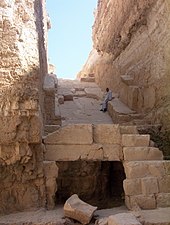30°01′55″N 31°04′30″E / 30.03194°N 31.07500°E


Abu Rawash (also spelled Abu Roach, Abu Roash; Arabic: ابو رواش Egyptian Arabic pronunciation: [ˈæbu ɾæˈwæːʃ], Coptic: ⲁⲃⲣⲱⲟⲩϣⲓ abrowshi, Coptic pronunciation: [ɑbˈroːwʃi], "flesh of sensual pleasures"[1]), 8 kilometres (5.0 mi) north of Giza, is the site of Egypt's most northerly pyramid, also known as the lost pyramid – the mostly ruined Pyramid of Djedefre, the son and successor of Khufu. Originally, it was thought that this pyramid had never been completed, but the current[when?] archaeological consensus is that not only was it completed, but that it was built about the same size as the Pyramid of Menkaure – the third largest of the Giza pyramids. It is the location of the northernmost pyramid in Egypt (known as Lepsius Number One), the pyramid of Djedefre (also known as Radjedef) and around fifty mastabas (located one and a half kilometres from Djedefre’s pyramid).[2] The excavation report on the pyramid complex was published in 2011.[3]
- ^ Czarkiewicz, Andrzej (1971). Ancient Egyptian and Coptic Elements in the Toponomy of Contemporary Egypt. pp. 72–73.
- ^ "Abu Rawash | Ancient Egypt Online". Retrieved 2022-07-22.
- ^ Valloggia, Michel (2011). Abou Rawash. I, Le complexe funéraire royal de Rêdjedef : étude historique et architecturale. Le Caire. ISBN 978-2-7247-0568-3. OCLC 731043888.
{{cite book}}: CS1 maint: location missing publisher (link)